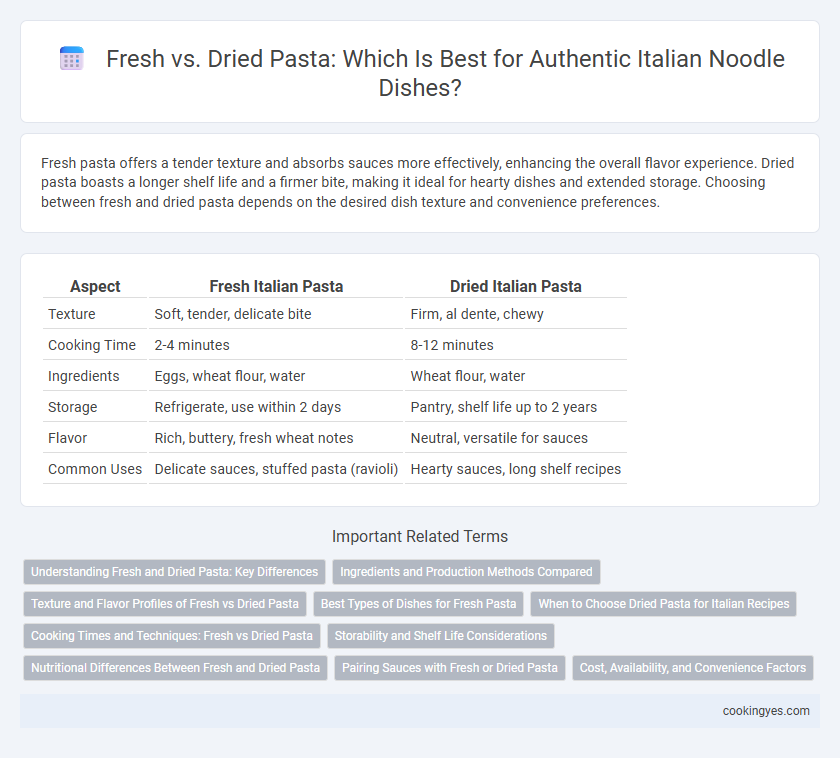Fresh pasta offers a tender texture and absorbs sauces more effectively, enhancing the overall flavor experience. Dried pasta boasts a longer shelf life and a firmer bite, making it ideal for hearty dishes and extended storage. Choosing between fresh and dried pasta depends on the desired dish texture and convenience preferences.
Table of Comparison
| Aspect | Fresh Italian Pasta | Dried Italian Pasta |
|---|---|---|
| Texture | Soft, tender, delicate bite | Firm, al dente, chewy |
| Cooking Time | 2-4 minutes | 8-12 minutes |
| Ingredients | Eggs, wheat flour, water | Wheat flour, water |
| Storage | Refrigerate, use within 2 days | Pantry, shelf life up to 2 years |
| Flavor | Rich, buttery, fresh wheat notes | Neutral, versatile for sauces |
| Common Uses | Delicate sauces, stuffed pasta (ravioli) | Hearty sauces, long shelf recipes |
Understanding Fresh and Dried Pasta: Key Differences
Fresh pasta contains higher moisture content, resulting in a soft texture and shorter cooking time, while dried pasta is made by dehydrating dough for long shelf life and a firmer bite. Fresh pasta is often preferred for delicate sauces, whereas dried pasta pairs well with robust, hearty sauces due to its denser structure. Understanding these differences allows chefs to select the ideal pasta type for specific Italian dishes, enhancing flavor and texture profiles.
Ingredients and Production Methods Compared
Fresh Italian pasta is made from soft wheat flour and eggs, producing a tender texture ideal for delicate sauces, while dried pasta uses durum wheat semolina and water, resulting in a firmer bite suitable for robust dishes. The production of fresh pasta involves manual rolling or extrusion and immediate cooking, preserving moisture and a delicate flavor. In contrast, dried pasta undergoes slow drying at controlled temperatures to maximize shelf life without sacrificing protein structure, making it a pantry staple with extended usability.
Texture and Flavor Profiles of Fresh vs Dried Pasta
Fresh Italian pasta boasts a tender, silky texture that absorbs sauces more readily, providing a delicate yet rich flavor profile prized in dishes like fettuccine alfredo. Dried pasta, crafted through slow drying processes, exhibits a firmer, chewier bite and a more concentrated wheat flavor, ideal for robust sauces such as ragu or arrabbiata. Understanding the nuanced differences in texture and flavor helps chefs select the optimal pasta type to elevate Italian culinary experiences.
Best Types of Dishes for Fresh Pasta
Fresh pasta offers a delicate texture and tender bite, making it ideal for light sauces such as butter, olive oil, or simple tomato-based sauces. Dishes like fettuccine Alfredo, tortellini with cream sauce, and lasagna layers benefit from fresh pasta's ability to absorb flavors while maintaining softness. Fresh pasta is best for recipes requiring quick cooking and a silky mouthfeel, enhancing dishes with rich, creamy, or subtle ingredients.
When to Choose Dried Pasta for Italian Recipes
Dried pasta is ideal for hearty Italian recipes like baked ziti or lasagna, where its firm texture holds up well during long cooking times and baking. It also works best for robust sauces such as marinara or Bolognese, allowing the pasta to absorb flavors without becoming mushy. Choose dried pasta for easy storage, extended shelf life, and consistent results in traditional Italian dishes that benefit from a more resilient noodle.
Cooking Times and Techniques: Fresh vs Dried Pasta
Fresh pasta cooks significantly faster, typically in 2 to 4 minutes, due to its higher moisture content and delicate texture, making it ideal for light sauces and quick meals. Dried pasta requires a longer cooking time, usually 8 to 12 minutes, as it has a denser structure and lower moisture, which allows it to hold up well in hearty sauces and baked dishes. Precise cooking times and water temperature control are essential for both types to achieve the perfect al dente texture, ensuring optimal pasta quality and flavor retention.
Storability and Shelf Life Considerations
Fresh Italian pasta typically has a shorter shelf life, lasting only 2 to 3 days in the refrigerator due to its higher moisture content, making it ideal for immediate use but requiring careful storage in an airtight container to maintain freshness. Dried pasta, in contrast, boasts a much longer shelf life, often up to 1 to 2 years when stored in a cool, dry place, offering flexibility and convenience for long-term storage without compromising quality. Choosing between fresh and dried pasta involves balancing immediate culinary needs with storage capabilities and shelf life expectations.
Nutritional Differences Between Fresh and Dried Pasta
Fresh pasta typically contains higher moisture content and fewer preservatives, resulting in slightly more vitamins like B-complex and folate compared to dried pasta. Dried pasta has a longer shelf life and often contains more concentrated carbohydrates and protein per serving due to its lower water content. Both types provide essential nutrients such as iron and fiber, but fresh pasta may offer a marginally better nutritional profile due to less processing.
Pairing Sauces with Fresh or Dried Pasta
Fresh pasta's tender texture excels with delicate sauces like light tomato, cream-based, or herb-infused olive oil, allowing the subtle flavors to shine without overpowering. Dried pasta's firm, chewy bite pairs well with robust, hearty sauces such as rich Bolognese, spicy arrabbiata, or thick ragu, providing structure to hold thick sauces effectively. Selecting the right pasta type enhances the balance between noodle texture and sauce intensity for authentic Italian flavor harmony.
Cost, Availability, and Convenience Factors
Fresh Italian pasta typically costs more than dried pasta due to its shorter shelf life and specialized production process, making it a premium choice in many markets. Dried pasta offers greater availability and convenience, with a long shelf life and easy storage, which appeals to consumers prioritizing cost-efficiency and readiness. Availability of fresh pasta can be limited to specialty stores, while dried pasta is widely accessible in supermarkets globally, making it the go-to choice for everyday cooking.
Fresh vs Dried for Italian Pasta Infographic

 cookingyes.com
cookingyes.com